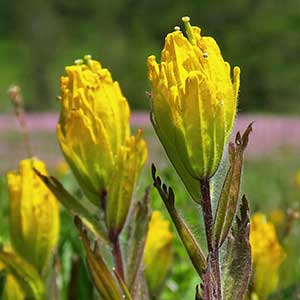Castilleja levisecta
Castilleja arachnoidea
golden Indian paintbrush, golden paintbrush
cobwebby Indian paintbrush, cobwebby paintbrush, cotton paintbrush
few to many, erect, ± decumbent or creeping at base, unbranched, sometimes branched, hairs spreading, medium length and long, soft, mixed with short stipitate-glandular ones.
solitary or few to many, decumbent-ascending, unbranched, sometimes branched, hairs dense, reflexed-spreading, matted, long, soft, unbranched, eglandular, white-woolly.
green to purple or brown-tinged, linear-lanceolate proximally, oblong-ovate or -obovate distally, 0.8–5.2 cm, not fleshy, margins plane, distalmost sometimes ± wavy, involute, 3–7(–11)-lobed, apex obtuse;
lobes erect to ascending, linear to linear-spatulate, very short, toothlike, usually arising from distal 1/3 of blade, apex rounded.
green to purple or steel gray, lanceolate-linear or narrowly lanceolate, (1–)2–4(–6) cm, not fleshy, margins plane, involute, 3(–5)-lobed, apex acute;
lobes spreading, linear to lanceolate, apex acute to rounded.
2.5–25 × 1–4 cm;
bracts bright yellow throughout, or proximally greenish, distally bright yellow, sometimes deep yellow-orange, especially with age, oblong, elliptic, or obtuse to ovate, (0–)5–9(–13)-lobed, sometimes wavy-margined;
lobes erect to ascending, oblong, short to medium length, arising above mid length, central lobe apex rounded, lateral ones rounded to acute.
erect to ascending, 3–12 × 1–2.5 cm;
bracts proximally greenish to dull reddish brown, rarely dull red or dull orange, distally dull red, deep rusty red, or yellow to pale yellow, sometimes deep pink, dull rose, pale salmon, or dull light orange, rarely green, dull reddish, or dull orange throughout, aging browner and/or more orange, lanceolate or elliptic-lanceolate to obovate, (0–)3–5-lobed;
lobes usually ascending, linear, lanceolate, oblanceolate, or spatulate, long, arising near or below mid length, central lobe apex rounded to truncate, others obtuse to rounded.
straight or slightly curved, 17–28 mm;
tube 12–15 mm;
beak exserted, adaxially green or greenish yellow, 6–8 mm;
abaxial lip yellow or greenish, reduced, not inflated, 2–3 mm, 25–33(–50)% as long as beak;
teeth ascending to erect, yellow, 0.5–1.5 mm.
straight or ± curved, 12–20 mm;
tube 9–15 mm;
beak subequal to calyx or slightly exserted, adaxially green or yellow-green, (2–)3–5 mm, ± densely puberulent, hairs often crisped;
abaxial lip yellow, greenish, pink, or red-violet, moderately conspicuous, exserted to barely included in calyx;
pouches shallow, prominent, 2–4 mm, ca. 100% as long as beak;
teeth erect, red, pink, or pale yellow, 1 mm.
distally yellow, 13–22 mm;
abaxial and adaxial clefts 4–9.5 mm, 30–40% of calyx length, deeper than laterals, lateral 2.5–4.5 mm, ca. 25% of calyx length;
lobes linear to narrowly oblong or narrowly lanceolate, apex obtuse, sometimes rounded to acute.
colored as bracts, proximal part sometimes paler, (10–)12–19 mm;
abaxial and adaxial clefts 4–8(–10) mm, 33–50% of calyx length, all 4 clefts subequal;
lobes linear to lanceolate, apex acute.
= 24.
= 24.
Castilleja levisecta
Castilleja arachnoidea
Castilleja levisecta is listed as threatened in the United States and endangered in Canada, where it is extremely rare. Most of its grassland habitat has been altered by development in the Puget Trough, and there are historical stations in the metro areas of what are now Victoria, Portland, and Seattle. For several decades, C. levisecta was considered extirpated from Oregon. However, recent reintroduction programs in Oregon and Washington have been very successful at reestablishing this species at several sites in the Willamette Valley. The bright yellow inflorescences often gradually age to a golden yellow color, unique in the genus.
Castilleja levisecta is in the Center for Plant Conservation’s National Collection of Endangered Plants.
(Discussion copyrighted by Flora of North America; reprinted with permission.)
Castilleja arachnoidea is a remarkably variable species in form and color, but inflorescence colors are often uniform within a population. It is sometimes confused with C. schizotricha, but the two differ in stature, lobing of the leaves and bracts, bract coloration, and inflation of the abaxial lip. They are easily separated by the simple hairs and pale yellow to brick red inflorescences of C. arachnoidea, compared to the pink-purple to deep purple inflorescences and branched hairs of C. schizotricha.
The names Castilleja eastwoodiana and C. filifolia represent yellow color forms of C. arachnoidea. A race on the pumice plains of Mt. Shasta in the Cascade Range in California is distinctive.
(Discussion copyrighted by Flora of North America; reprinted with permission.)


